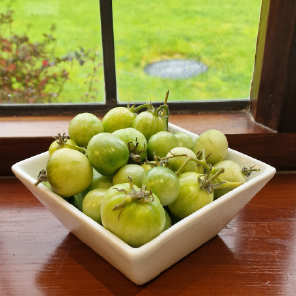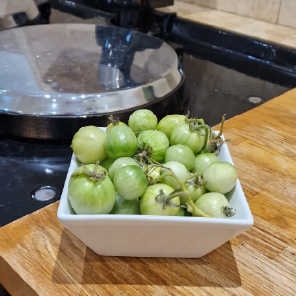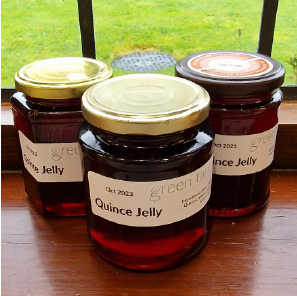Preserving fruit and vegetables
- Maryann & Martin
- Oct 30, 2023
- 4 min read
Here at Green Farm, we like to eat in season as much as we can. If you choose menus and recipes carefully, it is amazing how much can be done with produce that is actually available at the time of year, rather than preserved, frozen or tinned. That’s why this month we’re talking all about preserving fruit and vegetables, because whilst we have an abundance of produce, we are big believers in sustainable farming and living.

We were delighted to create a 5-course Harvest Feast for 20 guests at the end of October with fresh pork, fresh oxtail and no less than 18 different vegetables from the Community Wildlife Garden. The only produce that wasn’t fresh was frozen blackberries that we had collected a couple of months’ ago.
Nevertheless, preserving fruit and vegetables for later use can be very useful. This year we have, or will, preserve:
Blackberries
Cape gooseberries
Quinces
Apples
Red Tomatoes
Green Tomatoes
Read on for our tips on getting the most from your harvest and preserving fruit and vegetables.
Blackberries & Cape Gooseberries
This is really easy. Lay them out on a metal tray and place in the freezer. Once they have frozen, they can be put into a plastic container or bag. Cape Gooseberries (Physalis peruviana, also sometimes called Goldenberries), a species of ground cherry in the nightshade family, are absolutely divine added, still frozen to cold desserts – a little burst of chilled flavour.
Quince Jelly
We are lucky to have a long-established quince tree in our orchard that delivers a bounty of quinces about three years in four. For some reason it decides to produce no fruit at all every so often.
Pick the quinces when they are ripe (they will still be hard), just wash them and cut them into quarters. There is no need to peel or core them. Boil them with lemon juice and peel until they are mushy-soft – this is important to ensure that you are getting the maximum amount of natural pectin.
Strain the mixture through muslin to get the dark, golden liquid with nothing else. This can easily take 24 hours and can be dome using a colander lined with muslin over a large saucepan. Then add 300g – 400g preserving sugar for each ½ lire of quince juice. Bring to the boil over a low heat, stirring to dissolve the sugar. Bring to a rapid bubble and cook until the temperature reaches 105C.
Ladle into hot sterilised jars and seal.
Apples
Apples can be problematic to store for any length of time. The natural production of ethylene by the fruit is what makes them rot. So, the key for longer storage of apples so they last through the winter, is to choose apple varieties that produce the least ethylene and to minimise its further production.
In general, the later ripening apples will be the best for storage. Select the individual apples very carefully, separating (and eating straight away) any apple that has any bruising, cuts or blemishes that puncture the skin. The best way to store these is in a cold, damp environment; cold to minimise ethylene production and damp to stop the skins drying out.
If you have sufficient fridge space, then great. Chill the apples in the fridge then seal them in plastic bags with a bit of damp kitchen paper and keep in the fridge. Without a fridge, still chill them as much as possible, store them in boxes, separated, wrapped in newspaper if you like and keep in as cool an area you can find – just one or two degrees above freezing is perfect. This could be a garden shed that’s in the shade or a purpose-built outdoor storage cabinet on the north side of a building with holes in the doors for ventilation.
A simple option that can work over the winter is to place a number of apples very carefully into a hessian sack and hang them from a tree in the orchard. They might loose a bit of their crunch if the weather goes too far below freezing but otherwise they should be fine.
Red Tomatoes
We use a lot of roasted tomatoes in our cooking. Whenever a cooked recipe calls for tomatoes, we always roast the tomatoes in the aga for more than an hour; if possible until they have just started to caramelise. This gives such a different flavour to the dish.
So, to keep tomatoes, cut them in half and place cut-side up in a roasting dish. Drizzle a reasonable amount of olive oil and sprinkle salt all over them. Place them in a 160o – 180 o oven for an hour or so, until they just start to caramelise. Let them cool and place them in a tub in the freezer. Simple.
Green Tomato Chutney
Slice the tomatoes (you can skin them if you want, but it's not necessary). Finely chop onions (one fifth the weight of the tomatoes). Layer both in a large bowl with some salt and leave overnight.
The next day, organise the same weight of sultanas, apples, and muscovado sugar as you had onions together with a large jar of pickling vinegar (any vinegar that has at least 5% acidity). Chop the sultanas using a sharp knife, and peel, core and chop the apples. Put the sugar and vinegar into a large pan and bring to the boil, stirring to dissolve the sugar. Add the sultanas and apples and simmer for 10 mins. Strain the tomatoes and onions in a colander (but don’t rinse), then tip into the pan and return to the boil.
Simmer for about 1 hr, stirring occasionally until the mixture is thick and pulpy. Transfer to warmed jars and cover with lids.
We hope you have found these ideas inspiring and that we can encourage you to make the most of your food produce. Not only does preserving fruit and vegetables cut down on waste and benefit the environment, it benefits your bank balance too. If you have tips and tricks around preserving fruit and vegetables or storing food for longevity, please do share them with us on our Instagram or Facebook pages.
Let’s enjoy good quality, nourishing food and spread the word on sustainable living while we’re at it.







